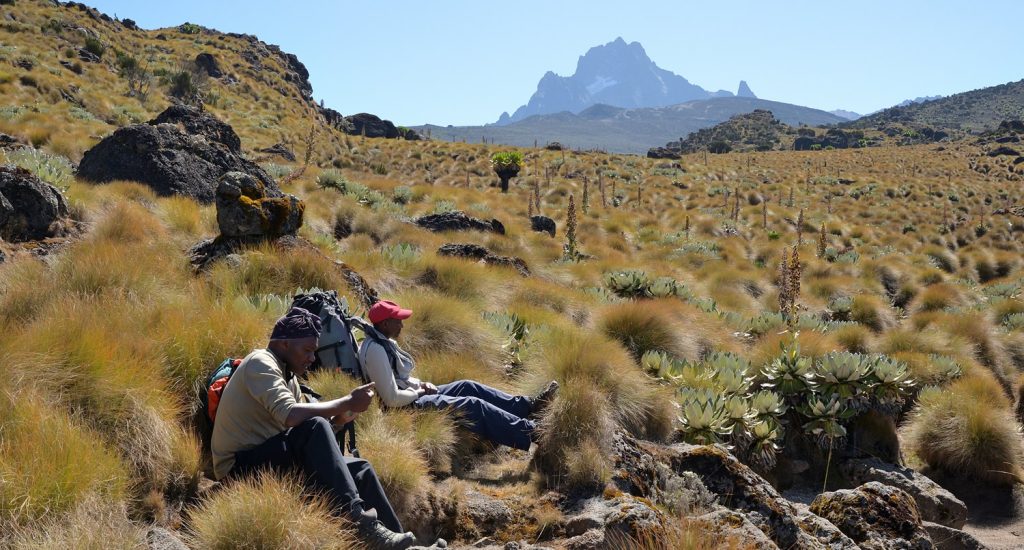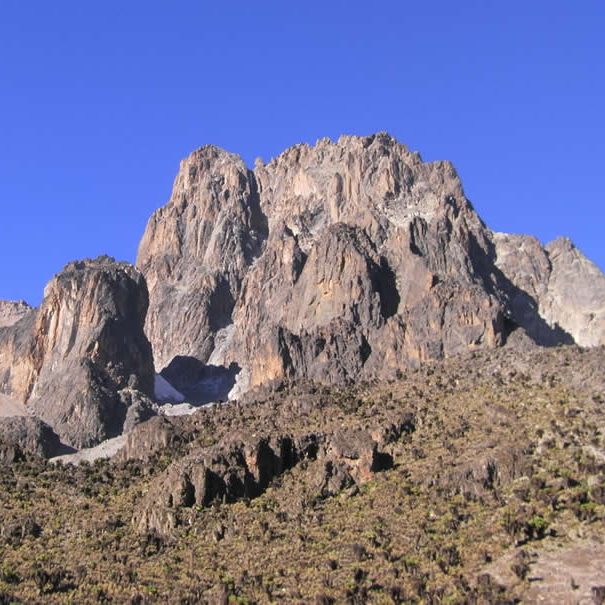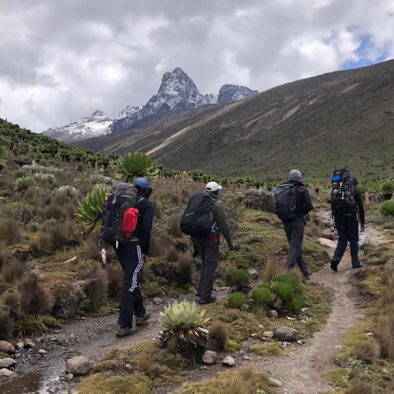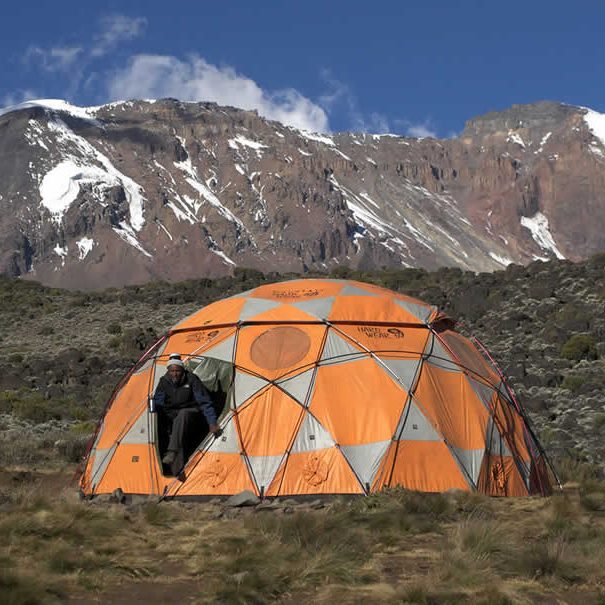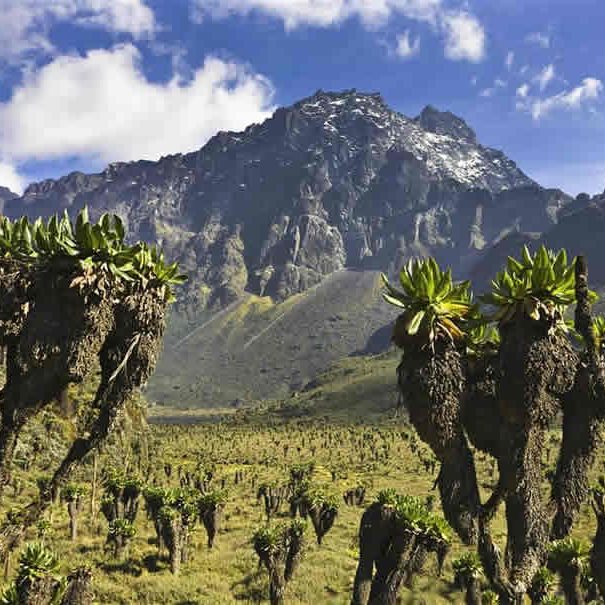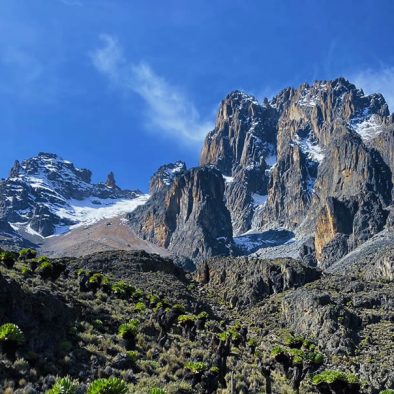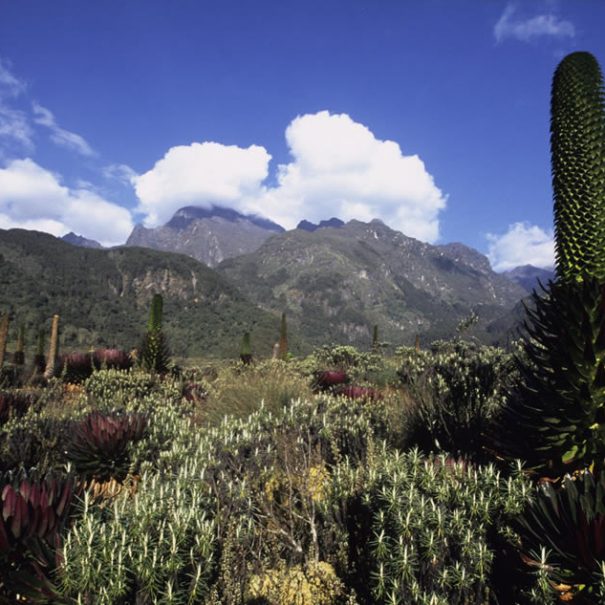At the heart of Kenya, the towering presence of Mount Kenya serves as more than a symbol of national pride. Home to the rich flora and fauna of Mount Kenya, this mountain, Africa’s second-highest, unveils an exceptional array of biodiversity, creating an enchanting tableau of life on its vibrant slopes.
In this article, we delve deep into Mount Kenya’s unique flora and fauna, examining the incredible array of plant and animal life that thrives in this high-altitude environment. From towering trees to tiny alpine flowers, and from majestic elephants to elusive leopards, the mountain’s slopes are home to an astonishing variety of life that is both fascinating and fragile.
Mount Kenya’s Ecosystem
Mount Kenya’s ecosystem is a unique and diverse environment that spans a wide range of altitudes, from the lowland forests at the mountain’s base to the alpine moorlands and glaciers at its peak.
The mountain’s slopes are characterized by a range of habitats, including dense rainforests, bamboo forests, heathlands, and grasslands, which provide a home to an incredible variety of flora and fauna. The ecosystem is influenced by Mount Kenya’s high elevation, which creates a range of microclimates that support a diverse range of life.
Mount Kenya’s slopes are renowned for their high level of biodiversity, with an estimated 5,000 plant and animal species living on the mountain. The mountain is particularly known for its unique plant species, including giant lobelias, which can grow up to 6 meters tall, and giant groundsel, which can reach heights of 10 meters. The slopes are also home to a range of animal species, including elephants, buffaloes, antelopes, monkeys, and a variety of bird species.
The Flora on Mount Kenya’s Slopes
Mount Kenya’s slopes are home to a diverse range of plant species, with an estimated 2,500 species of plants growing on the mountain. The vegetation on the mountain is influenced by altitude, with different plant species growing at different elevations.
· High-altitude vegetation: montane forest and bamboo zones
The montane forest zone is found on the lower slopes of Mount Kenya, typically between 2,000 and 3,000 meters (6,500 and 9,800 feet) in altitude. It is a lush and diverse ecosystem characterized by tall trees, dense undergrowth, and a rich variety of plant species. The montane forest acts as an important water catchment area, contributing to the mountain’s freshwater resources.
Within the montane forest, one can find various tree species, including camphor (Ocotea usambarensis), olive (Olea europaea), and African pencil cedar (Juniperus procera). These trees provide shade, create a moist microclimate, and support a thriving understory. The forest floor is covered with a carpet of ferns, mosses, and lichens, adding to the overall biodiversity.
Above the montane forest lies the bamboo zone, typically between 2,700 and 3,800 meters (8,800 and 12,500 feet) in altitude. The dominant plant species in this zone is the giant bamboo (Yushania alpina). Bamboo plays a crucial role in the ecosystem of Mount Kenya.

Bamboo helps stabilize the soil on steep slopes, preventing erosion. Its dense growth also acts as a barrier against strong winds. The bamboo thickets provide habitat and food for various animal species, including elephants, buffalos, and several primate species.
Bamboo exhibits unique adaptations to survive in the challenging mountain environment. It has strong, flexible stems that can withstand heavy snow loads. It also has a rapid growth rate, allowing it to quickly recover from disturbances such as landslides or fires.
· Alpine zone: heathland and moorland vegetation
The alpine zone on Mount Kenya, which starts around 3,800 meters (12,500 feet) and extends up to 4,500 meters (14,800 feet), consists of heathland and moorland. These vegetation types are adapted to the harsh conditions of high altitude, including low temperatures, strong winds, and limited nutrients.
Heathland is characterized by low shrubs and tussock grasses. It is dominated by plants such as Helichrysum species and Protea kilimandscharica. The tussock grasses form beautiful clumps and provide insulation against cold temperatures.
Moorland, on the other hand, is characterized by a more open landscape with patches of grasses and scattered shrubs. It is home to unique plant species such as giant groundsels (Senecio species), lobelias (Lobelia species), and everlasting flowers (Helichrysum species).
Subalpine and afro-alpine zones: unique and rare plant life
The subalpine and afro-alpine zones of Mount Kenya are located above the alpine zone, typically above 4,500 meters (14,800 feet). These zones are characterized by extreme conditions including low temperatures, strong winds, rocky terrain, and limited moisture availability. Despite the challenges, these zones support unique and rare plant life that has adapted to survive in this harsh environment.
The subalpine zone is marked by low-growing grasses, cushion plants, and scattered shrubs. As the elevation increases, the landscape transitions into the afro-alpine zone, which is more barren and rocky. These zones are often above the tree line, resulting in a unique and distinct flora.
The Fauna of Mount Kenya’s Slopes
· Mammals
Mount Kenya’s slopes support a diverse range of mammal species, showcasing the richness of the mountain’s ecosystem. The presence of various habitats, from the lower montane forest to the higher alpine zones, provides different niches for mammals to thrive. These mammals play vital roles in the ecosystem, contributing to seed dispersal, pollination, and maintaining the balance of predator-prey relationships.
Among the notable mammal species found on Mount Kenya are:
African Elephants (Loxodonta africana): These majestic creatures inhabit the lower slopes of Mount Kenya. They play a crucial role in shaping the environment through their feeding and browsing habits, as well as in seed dispersal over large distances.
Cape Buffalos (Syncerus caffer): These large herbivores can be found in the montane forest and bamboo zones of Mount Kenya. They contribute to vegetation dynamics and are often seen in small herds, grazing on grasses and browsing on shrubs.
Primates
Mount Kenya is home to various primate species, including the Black and White Colobus Monkey (Colobus guereza) and the Sykes’ Monkey (Cercopithecus mitis). These agile and acrobatic primates inhabit the forested slopes, feeding on leaves, fruits, and occasionally insects.
· Birds
The slopes of Mount Kenya boast a rich diversity of birdlife, making it a paradise for birdwatchers and ornithologists. The varied habitats, ranging from forested areas to open moorlands, provide a wide array of niches for different bird species.
The avian diversity of Mount Kenya includes both endemic and migratory species. Some notable birds found on the slopes of Mount Kenya are:
Jackson’s Francolin (Francolinus jacksoni): This endemic bird species is found in the montane forest and bamboo zones of Mount Kenya. It is known for its distinctive call and is highly sought after by bird enthusiasts.
Verreaux’s Eagle (Aquila verreauxii): This magnificent raptor can be observed soaring above the alpine zones of Mount Kenya. It is well-adapted to the mountain environment and preys on small mammals and birds.
Scarlet-tufted Malachite Sunbird (Nectarinia johnstoni): This beautiful sunbird is endemic to Mount Kenya. Its vibrant colors and long, curved bill make it a captivating sight for birdwatchers.
· Reptiles and Amphibians
The slopes of Mount Kenya also provide habitats for a variety of reptiles and amphibians. These cold-blooded creatures are adapted to the mountain’s unique climatic conditions and play essential roles in the ecosystem, such as controlling insect populations and serving as prey for predators.
Some notable reptile and amphibian species found on Mount Kenya are:
Jackson’s Chameleon (Trioceros jacksonii): This iconic reptile is known for its ability to change colors. It inhabits the montane forest and is adapted to live in the trees, using its prehensile tail and grasping feet to navigate its arboreal habitat. Its independently moving eyes help it scan the surroundings for prey and predators.
East African Green Snakes (Philothamnus spp): These slender, arboreal snakes are commonly found in the forested areas of Mount Kenya. They are excellent climbers, using their long bodies and agile movements to navigate the trees in search of prey, such as small birds and lizards.
Mount Kenya Bush Viper (Atheris desaixi): This venomous snake is endemic to Mount Kenya. It has adapted to the high-altitude environment and is typically found in forested areas. Its coloration and patterning provide effective camouflage among the leaf litter, allowing it to ambush unsuspecting prey.
Mount Kenya Reed Frog (Hyperolius montanus): This endemic amphibian species is found in the montane forest and bamboo zones. It has adapted to life near streams and wetlands, with its long, adhesive toes enabling it to cling to vegetation. The vibrant colors of the male frogs serve as visual cues during courtship.
Alpine Toad (Bufo alpinus): This unique amphibian species is well-adapted to the harsh conditions of the alpine zone on Mount Kenya. It has a robust body and thick skin, which help it retain moisture and withstand low temperatures. The toad hibernates during the cold season and emerges when conditions are more favorable.

